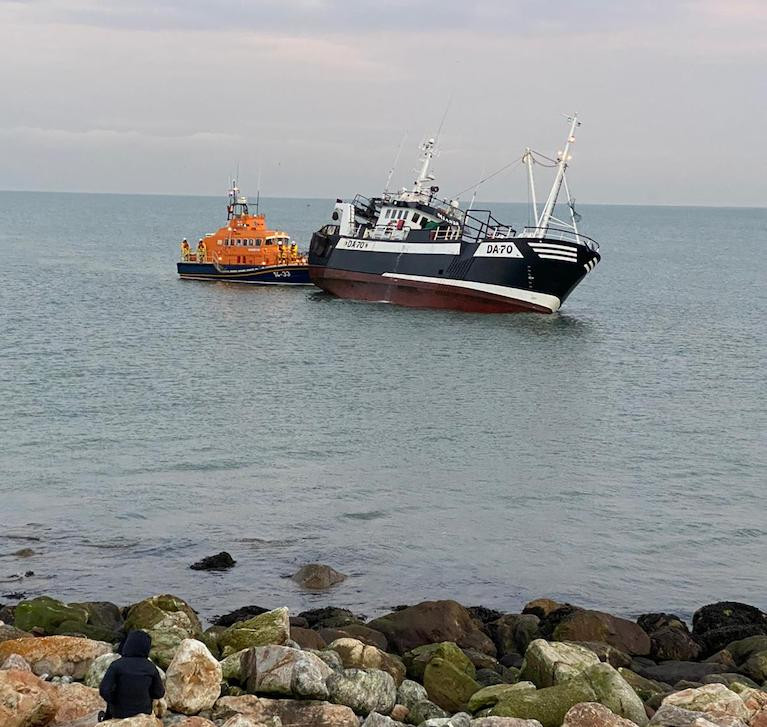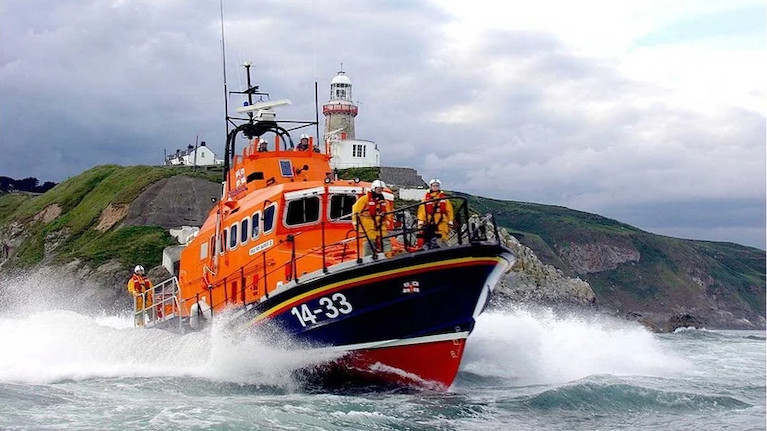Displaying items by tag: Fishing Trawler
British Gillnetter Which Starred in TV Series Detained off Irish Coast
A British-registered gillnetter which featured on a Channel 4 television series on fishing has been detained by the European Fisheries Control Agency (EFCA) off the Irish coast.
The 23 metre Govenek of Ladram, which played a starring role in the series, The Catch, has been escorted into Castletownbere, Co Cork.
It was detained by the EFCA's fishery protection vessel Aegis 1 in the Celtic Sea for alleged fishing offences.
The EFCA, based in Vigo, Spain, said the vessel was inspected by two Irish fishery officers, who were on board the European agency’s charter vessel, Aegis 1, “in the framework of EFCA´s joint deployment plan for western waters”.
An EFCA spokeswoman said Ireland’s Sea Fisheries Protection Authority (SFPA) requested the Aegis 1 to escort the detained vessel to Castletownbere port.
The 1986-built British registered gillnetter is based in Newlyn, Cornwall, and is part of a fleet run by a family-owned fishing company.
It fishes for hake, monkfish and turbot, using static gill and trammel nets.
Its skipper Phil Mitchell and crew vividly portrayed the everyday lives of fishermen when the Channel 4 series was broadcast in 2015.
The EFCA organises joint fisheries control and inspection activities in EU waters through a specific control and inspection programme adopted by the European Commission in association with member states.
Authorised fisheries inspectors use EFCA chartered vessels, with activities always co-ordinated by an EFCA official on board, the EU agency says.
Ireland’s SFPA officers are currently engaged in industrial action over terms and conditions, which began with a 24 hour work stoppage earlier this week.
Fishing Vessel Sinks off Kenmare Bay, Coast Guard Expresses Relief That There Was No Loss of Life (Video)
The fishing vessel Ellie Adhamh, the seven-person crew of which were evacuated by Coast Guard Helicopters on Saturday evening, has sunk in approximately 80m of water over two miles North of the Bull Rock, at the entrance to Kenmare Bay.
Valentia Coast Guard who coordinated the operation monitored the vessels situation overnight as it drifted in a northerly direction.
A local Tug hired by the owners was on scene all morning evaluating options to tow the vessel to a place of safety.
A second local Tug was also proceeding to the scene but it was evident from early morning that the vessels condition was deteriorating.
 The bow of the fishing vessel Ellie Adhamh seconds before the trawler sank in approximately 80m of water over two miles North of the Bull Rock, at the entrance to Kenmare Bay. See vid below
The bow of the fishing vessel Ellie Adhamh seconds before the trawler sank in approximately 80m of water over two miles North of the Bull Rock, at the entrance to Kenmare Bay. See vid below
A Coast Guard spokesperson expressed relief that there was no loss of life and acknowledged the professionalism of all who had been involved in the operation, as Afloat reported previously including Naval Service ship LE George Bernard Shaw, Castletownbere RNLI, Coast Guard Helicopter crews, owners and their representatives.
Howth RNLI Rescue Fishing Trawler & Crew After Running Aground
Howth RNLI launched the all-weather lifeboat to rescue a fishing trawler, six people, onboard after it ran aground on rocks in Balscadden Bay, at Howth in County Dublin.
The RNLI pagers sounded at 4.12 pm on Thursday 7th January to reports of a fishing trawler aground just outside Howth Harbour in Balscadden Bay. The all-weather lifeboat was launched and was on the scene in a matter of minutes.
The trawler was hard around and listing to one side. The lifeboat crew assessed the fishing trawler and deemed it safe to put a tow line aboard. Fred Connolly, Howth RNLI Lifeboat Coxswain carefully navigated the all-weather lifeboat in the shallow water and the volunteer crew got a tow line aboard the stricken trawler.
 The tide was rising and the lifeboat eased the trawler off the rocks and into deeper water
The tide was rising and the lifeboat eased the trawler off the rocks and into deeper water
The tide was rising and the lifeboat eased the trawler off the rocks and into deeper water. The trawler was brought back to the safety of Howth Harbour.
The Howth Lifeboat and volunteer crew returned to Howth station and stood down at 5.50 pm.
 The fishing trawler aground in Balscadden Bay Photo: Annraoi Blaney
The fishing trawler aground in Balscadden Bay Photo: Annraoi Blaney
Speaking following the callout, Ian Malcolm, Howth RNLI Deputy Launching Authority said: ‘Our volunteer lifeboat crew were pleased to be able to quickly respond and tow the fishing vessel to the safety of Howth Harbour. Our Lifeboat volunteers train regularly to prepare for situations just like this’’
The crew on the Howth RNLI Trent Class All Weather lifeboat were; Fred Connolly - Coxswain, Ian Sheridan - Mechanic, Killian O’Reilly, Ian Martin, Aidan Murphy, Stephan Mullaney and Ronan Murphy.
Howth RNLI All-Weather Lifeboat Rescue Fishing Trawler Stranded in Irish Sea
Howth RNLI launched the all-weather lifeboat to rescue a fishing trawler with steering problems just off Skerries in North Dublin.
The RNLI pagers sounded at 3.02 am on Wednesday 30th December to reports of a fishing vessel in difficulty south-east of Skerries. The all-weather lifeboat was launched and located the stricken fishing vessel which had no steering and unable to manoeuvre.
The volunteer lifeboat crew took the fishing vessel in tow and brought the vessel to the safety of Skerries harbour.
The crew of the fishing vessel were in good spirits despite the mechanical failure.
The Howth Lifeboat and volunteer crew returned to Howth station and stood down at 5.45 am.
Speaking following the callout, Fred Connolly, Howth RNLI Lifeboat Coxswain said: ‘Our volunteer lifeboat crew are always ready to respond to a call for help even in the early hours and we train for situations just like this. We were delighted to be able to quickly locate the fishing vessel, commence the tow and bring the vessel safely back to Skerries’.
Navy Escort Detained Trawler to Castletownbere
Less then a month ago the Naval Service detained a Northern Irish registered fishing vessel the Lynn Marie seven miles east off Bray Head. Onboard was a crew of 4 UK nationals who were taken into custody to the Gardai after the trawler was escorted by the CPV L.E. Orla to Dun Laoghaire Harbour. To read more about this detention click here.
Ironically the L.E. Orla was a former Royal Naval vessel, HMS Swift (P241) which was deployed on her first assignment to the Hong Kong Patrol Squadron for a four-year period. In 1988 Margaret Thatcher's Conservative Party Government disposed HMS Swift and HMS Swallow (P242) to the Irish Naval Service. The pair were built by Hall Russell Shipyard of Aberdeen as part of an eight 'Peacock' class coastal patrol vessel (CPV).
The 'Peacock' pair were commissioned into the Naval Service and renamed L.E. Orla (P41) and L.E. Ciara (P42) in a ceremony attended by An Taoiseach Charles J. Haughey at the Naval Base in Haulbowline, Cork Harbour.
This weeks' detention is the second conducted by the Naval Service in 2011. Last year the Naval Service carried out 1,666 vessel boardings which resulted in 70 warnings and eight detentions.
- Irish Naval Service
- Cork Harbour
- Northern Ireland
- Haulbowline
- castletownbere
- naval service
- LE Niamh
- Royal Navy
- Ports and Shipping News
- Lynn Marie
- Fishery Breaches
- Fishery Detention
- Fishing Trawler
- Peacock Class
- Hong Kong
- Hall Russell
- Appledore Shipbuilders
- LE Orla
- HMS Swift
- LE Ciara
- HMS Swallow
- Margaret Thatcher
- Conservative Party
- An Taoiseach
- Charles J. Haughey
- Naval Base































































